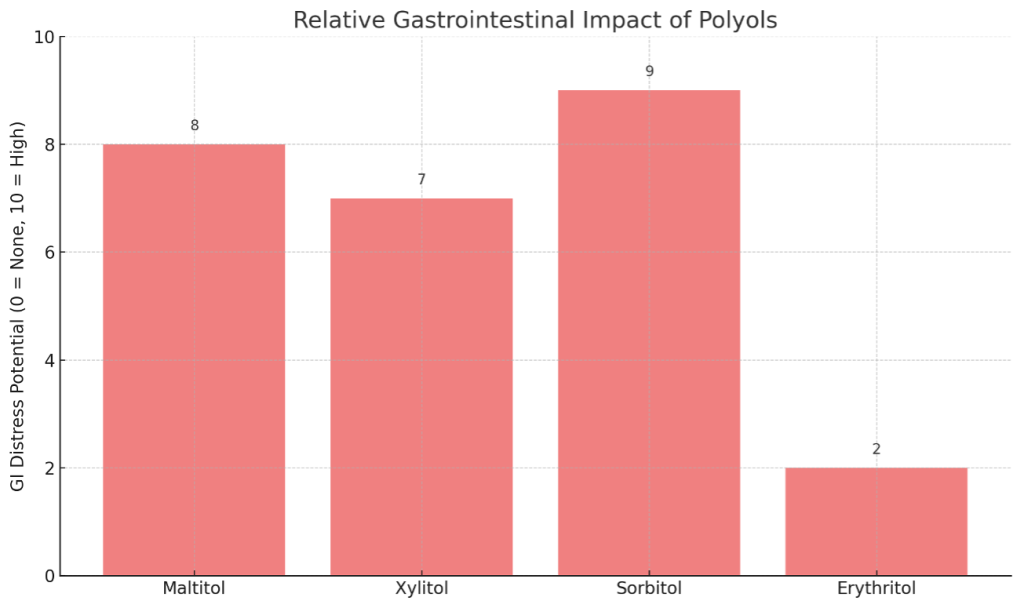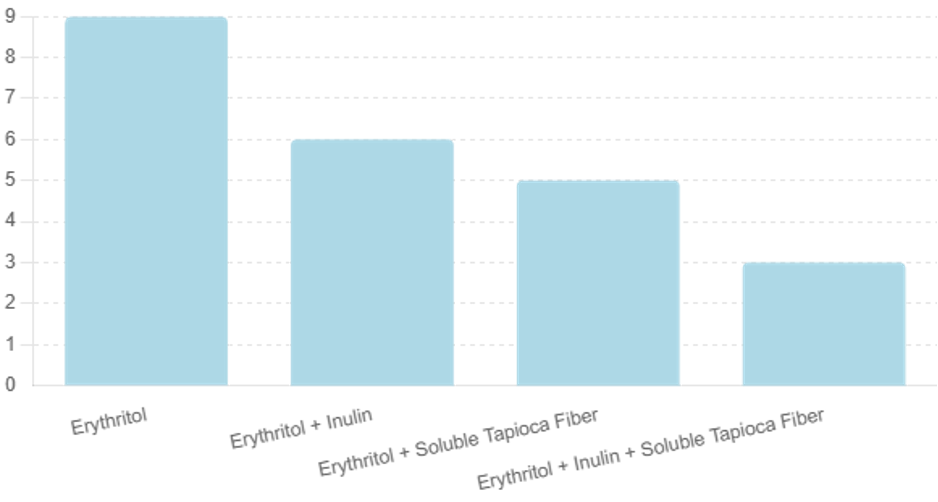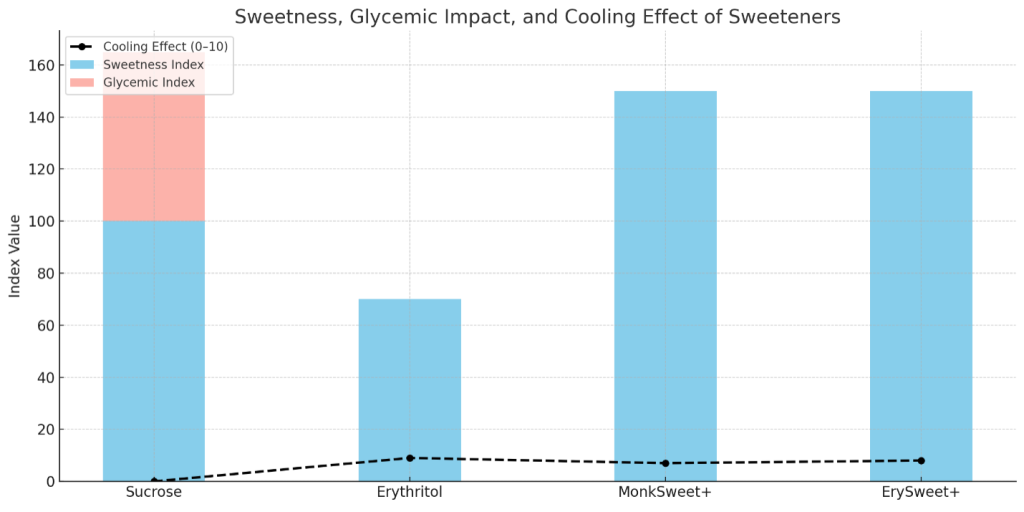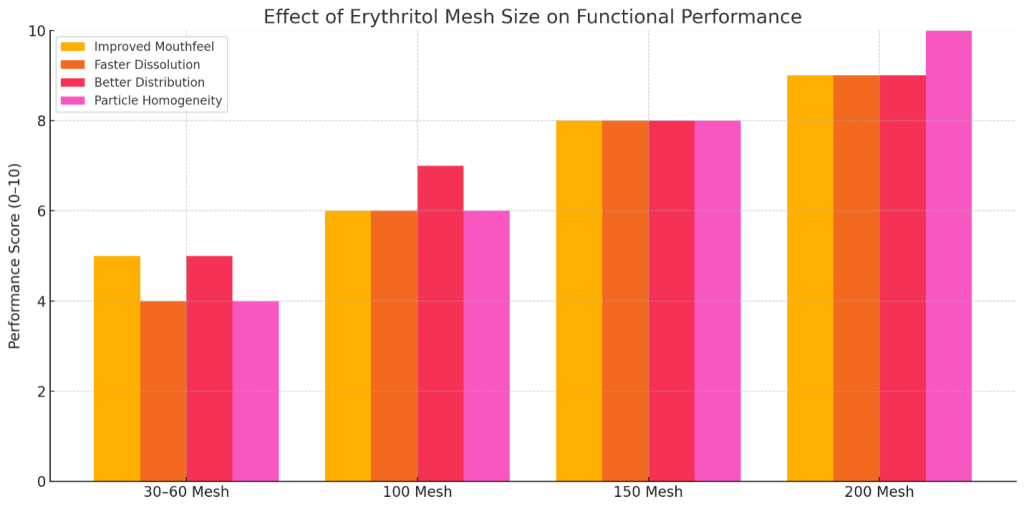The Polyol Lost but Not Forgotten: Erythritol in Food Formulations and Where It Fits
by Thom King, Icon Foods, Chief Innovations Officer/Food Scientist
Erythritol, a sugar alcohol with unique properties, has gained widespread attention in the 24 hours news cycle as well as the food industry as a low-calorie keto and GLP-1 friendly sweetener.
Let’s take a deep dive in the do’s, don’ts and advantages of incorporating erythritol into food formulations, focusing on the cooling effect, water activity, stability during thermal processing, reduction in added sugars, minimal gastrointestinal (GI) impact, and other benefits.
The rising demand for healthier food options, due in part to pressures from The Department of Health and Human Services, Make America Healthy Again (MAHA) initiatives has led to the increased use of low-calorie sweeteners. Erythritol, a naturally occurring sugar alcohol found in fruits and fermented foods, provides a viable alternative to traditional sweeteners. Indulge me whilst I elucidate the benefits of erythritol in food formulations, offering insights for food scientists and formulators.
Advantages of Erythritol in Food Formulations
Lowering Water Activity
- Erythritol effectively lowers water activity (aw) in food products, which can inhibit microbial growth and extend shelf life. By reducing aw, formulators can create products with enhanced stability and safety, particularly in low-moisture foods such as baked goods, confections, and snacks.
Stability in Thermal Processing
- Erythritol is stable at high temperatures, making it suitable for various thermal processing methods such as baking, frying, and extrusion. Unlike some other sweeteners that degrade under heat, erythritol maintains its sweetness and functional properties, making it an excellent choice for heat-treated products.
Clean Label Reduction of Added Sugars
- Incorporating erythritol allows for significant reductions in added sugars without compromising sweetness. This is particularly beneficial in products aimed at health-conscious consumers seeking to lower their sugar intake. Erythritol provides approximately 70% of the sweetness of sucrose but with only 0.2 calories per gram, making it an effective tool for sugar reduction strategies.
Minimal Gastrointestinal Impact
Erythritol is absorbed in the small intestine and excreted unchanged in urine, resulting in minimal gastrointestinal distress compared to other sugar alcohols. This quality makes erythritol suitable for products targeting consumers with sensitive digestive systems or those who are looking to reduce overall sugar alcohol intake.

Above is a graph comparing the gastrointestinal distress potential of common polyols:
- Sorbitol and maltitol are the most likely to cause GI issues (bloating, gas, laxative effect)
- Xylitol has moderate impact
- Erythritol shows the least GI impact due to its rapid absorption and excretion without fermentation
Additional Functional Benefits
- Erythritol possesses antioxidant properties and can contribute to the formulation of products with healthier profiles. Its crystalline structure can also enhance the texture and mouthfeel of various food products. Recent studies suggest that these compounds may influence the secretion of various gastrointestinal hormones, including glucagon-like peptide-1 (GLP-1), cholecystokinin (CCK), and peptide YY (PYY), while simultaneously reducing ghrelin levels. See: The Role of Erythritol and Xylitol in Stimulating GLP-1 Gastrointestinal Hormones: Implications for Appetite Regulation
Ideal Products for Erythritol
Erythritol is particularly effective in:
- Baked Goods: It provides moisture retention and sweetness without contributing to browning.
- Confectionery: Its ability to lower aw is beneficial for hard candies and gummies.
- Beverages: Erythritol can enhance sweetness while improving flavor profiles.
- Dairy Products: It helps in the formulation of reduced-sugar yogurts and ice creams where it can drive down freezing depression point.
- Snack Foods: Ideal for healthy snacks that require a sweet flavor without excess calories.
Synergy with High-Intensity Sweeteners and Sweetness Modulators
Erythritol pairs well with natural high-intensity sweeteners like stevia, monk fruit, and even sucralose. This combination allows formulators to achieve a balanced sweetness profile, reducing the bitterness sometimes associated with high-intensity sweeteners. Additionally, erythritol can act as a sweetness modulator, improving the overall flavor experience of reduced-sugar products by enhancing the perception of sweetness without the calories.
Erythritol offers numerous advantages for food scientists and formulators aiming to create healthier, low-calorie food products. Its ability to lower water activity, stability under heat, reduction of added sugars, minimal GI impact, and compatibility with other sweeteners make it a versatile ingredient in modern food formulation. However, let’s talk about one of the 800 lb. gorillas in the room and thar is it’s cooling effect.
Polyols, such as erythritol and xylitol have a characteristic cooling effect which if not addressed can be a barrier to consumer acceptance. Incorporating soluble tapioca fiber and inulin either separately or stacked can effectively reduce the cooling sensation associated with polyols like erythritol while enhancing formulation stability, texture, and fiber content.
To address the challenge or cooling, food formulators can leverage soluble tapioca fiber and inulin—both of which not only diminish the cooling effect but also offer additional health benefits.
Understanding the Cooling Effect of Polyols
Polyols such as erythritol and xylitol create a cooling sensation when dissolved in the mouth due to their endothermic dissolution process, which absorbs heat. This phenomenon can lead to an undesirable taste experience in certain products. Consequently, reducing the impact of this cooling effect is crucial for enhancing consumer satisfaction.
The Role of Soluble Tapioca Fiber and Inulin
- Soluble Tapioca Fiber
Soluble tapioca fiber, derived from cassava, is a prebiotic fiber known for its functional properties. Its incorporation into food formulations can help mitigate the cooling effect of polyols through the following mechanisms:
Gut Health Benefits: Inulin is recognized for its prebiotic properties, supporting digestive health and contributing to a more favorable nutritional label.
Texture Improvement: Soluble tapioca fiber can improve the mouthfeel of formulations, providing a creamy and smooth texture that counteracts the cooling sensation.
Prebiotic Benefits: As a source of soluble fiber, it promotes gut health and can improve the nutritional profile of the food product.
Inulin
Sweetness Enhancement**: Inulin can enhance the overall sweetness perception of formulations, allowing for a reduction in the amount of polyols required, which lessens the cooling effect.
Synergistic Flavor Masking: The creamy mouthfeel of inulin can help mask the cooling sensation, particularly in dairy and dessert products.

Above is a chart illustrating how the cooling effect diminishes when erythritol is blended with other fibers:
- Pure erythritol has the strongest cooling effect (~9/10)
- Blending with inulin or soluble tapioca fiber reduces the cooling
- A blend of erythritol with a stack of inulin, and soluble tapioca fiber significantly mitigates the cooling effect (to ~3/10), making it ideal for applications where a neutral sweetness profile is desired
Formulation Strategies
- Combining Polyols with Soluble Fibers
Food formulators can achieve a balanced sweetness and mouthfeel by blending polyols with soluble tapioca fiber and inulin. This combination can help create a more harmonious flavor profile while addressing the cooling sensation.
- Optimal Ratios
Determining the right ratios of polyols, soluble tapioca fiber, and inulin will depend on the specific application. Conducting sensory evaluations and consumer tests can aid in identifying the optimal blend for various product categories, including:
- Confectionery: At up to 4% reduces the cooling effect in gummies and chocolates.
- Baked Goods: At up to 6% enhances the texture and reduces cooling in cookies and cakes.
- Dairy Products and Frozen Desserts: At up to 5% Improves mouthfeel in yogurt, plant based frozen desserts and ice cream.
Incorporating soluble tapioca fiber and inulin into formulations containing polyols is a promising strategy for food formulators to mitigate the cooling effect while enhancing mouthfeel and making nutritional fact panels shine.
While erythritol is monosaccharide polyol and sugar is a disaccharide composed of two monosaccharides: glucose and fructose. This is where the two separate. Sucrose participates in the Maillard reaction which is the non-enzymatic browning reaction that occurs when proteins and sugars in food are heated. It leads to the development of complex flavors and a golden-brown crust in foods like bread, meat, and baked goods. Erythritol does not. Erythritol also dissolve into solution much slower additionally erythritol is only about 70% and sweet as sugar. This is where particle reduction and erythritol blends becomes your friends in process time, mouthfeel and taste.
Food formulators can maximize erythritols potential by employing blends with other sweeteners and optimizing its physical form through particle reduction.
Let’s explore the benefits of blending erythritol with high intensity sweetness for example MonkSweet+ where stevia monk fruit do the heavy lifting together and Erysweet+ where stevia strengthen the presentation in enhancing sweetness and streamlines processing time.
Erythritol is widely known for its low caloric content and sugar-like taste, is often used in various formulations. However, to optimize its performance and overall sensory attributes, food formulators can benefit from blending erythritol with other sweeteners and employing particle reduction techniques.
Benefits of MonkSweet+ and Erysweet+ Erythritol Blends
Enhanced Sweetness Profiles
Blending erythritol with high-intensity sweeteners like stevia and monk frit as found in MonkSweet+ (a blend of erythritol and monk fruit extract) and Erysweet+ (a blend of erythritol and stevia) can provide a more balanced sweetness profile. These blends not only enhance the overall sweetness but also help mask any off-tastes associated with high-intensity sweeteners. This results in a more palatable product.

Above is a chart overlaying:
- Sweetness Index (blue bars)
- Glycemic Impact (red-tinted overlay atop sweetness bars—only sucrose contributes to GI)
- Cooling Effect (dashed black line, scale 0–10)
This visualization highlights the appeal of MonkSweet+ and ErySweet+—delivering high sweetness without the glycemic load of sucrose and with a more moderate cooling effect than pure erythritol. Let me know if you want to visualize calorie contribution or digestive tolerance next.
Synergistic Effects
The combination of erythritol with stevia and or monk fruit can capitalize on the unique sweetness characteristics of each component. Monk fruit and stevia provide intense sweetness with fewer calories, while erythritol contributes to bulk and mouthfeel. This synergy allows formulators to reduce the overall sugar content while maintaining a desirable taste and texture.
Cost-Effectiveness
Using blends can be economically advantageous. By reducing the amount of expensive high-intensity sweeteners needed in a formulation, manufacturers can lower production costs while still meeting consumer expectations for sweetness and flavor.
Advantages of Particle Reduction
Particle reduction involves milling or grinding erythritol to achieve a finer particle size. This process can significantly enhance the solubility and dispersibility of erythritol in formulations, leading to several benefits:
- Improved Mouthfeel: Finer particles can contribute to a smoother texture, enhancing the overall eating experience. This is particularly important in products like chocolates, sauces, and beverages, where texture plays a critical role in consumer acceptance.
- Faster Dissolution: Reduced particle size allows erythritol to dissolve more quickly in solutions, streamlining the production process and reducing mixing times. This efficiency can be particularly beneficial in high-volume manufacturing settings.
- Better Distribution and Particle Homogony: Finer particles ensure a more uniform distribution of sweetness throughout the product, preventing localized sweet spots and enhancing the overall flavor profile.

Above is a comparative chart showing how mesh size impacts the functional performance of milled erythritol:
- Smaller mesh sizes (150–200 mesh) offer:
- Smoother mouthfeel
- Faster dissolution in liquids
- Better ingredient distribution
- Superior particle homogeneity (ideal for blends and coatings)
- Larger mesh sizes (30–60 mesh) are less refined and may leave a gritty texture, dissolve slower, and distribute less evenly.
Blends and Fine Particle Erythritol Application in Various Food Products
Particle reduction is especially beneficial in applications such as:
- Beverages: Fine erythritol and or blends particles dissolve quickly, ensuring a consistent sweetness without gritty residues.
- Baked Goods: Improved mouthfeel and texture can enhance the quality of cakes, cookies, and breads.
- Confections: For products like gummies and hard candies, fine particles can provide a smoother finish and prevent crystallization.
Maximizing the potential of erythritol in food formulations can be achieved through strategic blended products like MonkSweet+ and Erysweet+ and employing particle reduction techniques. These approaches not only enhance sweetness and mouthfeel but also streamline production processes, making them valuable strategies for food formulators.
Erythritol as well as MonkSweet+ (a blend of erythritol and monk fruit extract) and Erysweet+ (a blend of erythritol and stevia) sound almost like a perfect solution in some categories and it is.